
The tech industry is booming. The demand for skilled talent is at an all-time high and will only increase as technology continues to play an even bigger role in our day-to-day lives.
As the demand for tech talent grows, so does competition between companies. So, how do you stand out from the crowd when searching for new hires?
We must admit, it’s not an easy feat.
That’s why in this article, we’ll discuss some of the most effective strategies that can help you hire top tech talent and get them excited about working for you.
Let’s dive right in!
Table of Contents
Define your candidate’s profile
Tech companies today are feeling pressure to find the best coders possible. But that can be challenging because, when it comes to hiring top talent, you need to act fast.
In other words, you have about 10 days to make your pitch before they go off the market.

So, if you want to hire an engineer who can be a valuable asset to your team, you need to come prepared.
And the best way to do that is to create a candidate persona, a fictional character that represents your ideal developer.
You may wonder how you can create such a candidate persona?
To get a better understanding, we’re going to build it from scratch. First, we’ll name our candidate persona Engineer Jessica, and a fictional profile picture.
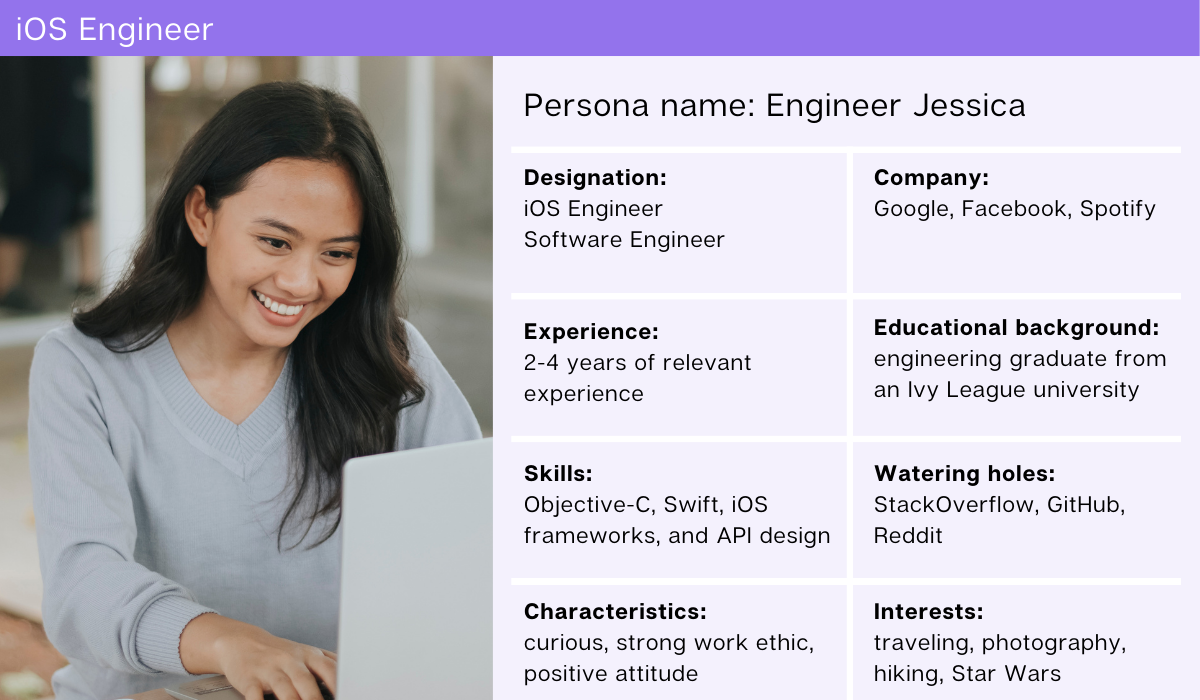
The next step should cover some basics that can easily be clarified by answering a few simple questions, such as:
- Who are we looking for for our job opening?
- What skills does this person have?
- Do they need any experience?
For example, our Engineer Jessica is an engineering graduate from an Ivy League university, and currently works as an iOS engineer, preferably at a top company like Google, Facebook, or Spotify.
She has been working as an iOS engineer for at least two years.
Her main responsibilities include developing new features for the company’s flagship product, maintaining existing code, and fixing bugs when they arise.
She is familiar with Objective-C, Swift, iOS frameworks, and API design.

Get unreal data to fix real issues in your app & web.
Next comes identifying traits that contribute to success in this role. This part of the process requires you to look beyond just technical skills and take into account soft skills too.
A lot of founders and CEOs when hiring top tech talents typically look for traits such as intellectual curiosity, speed and agility, quick thinking, continuous learning, and passion.
For example, Omar Tawakol, CEO and co-founder of Voicera, thinks that high competence that is devoid of arrogance is critical for success in his company.
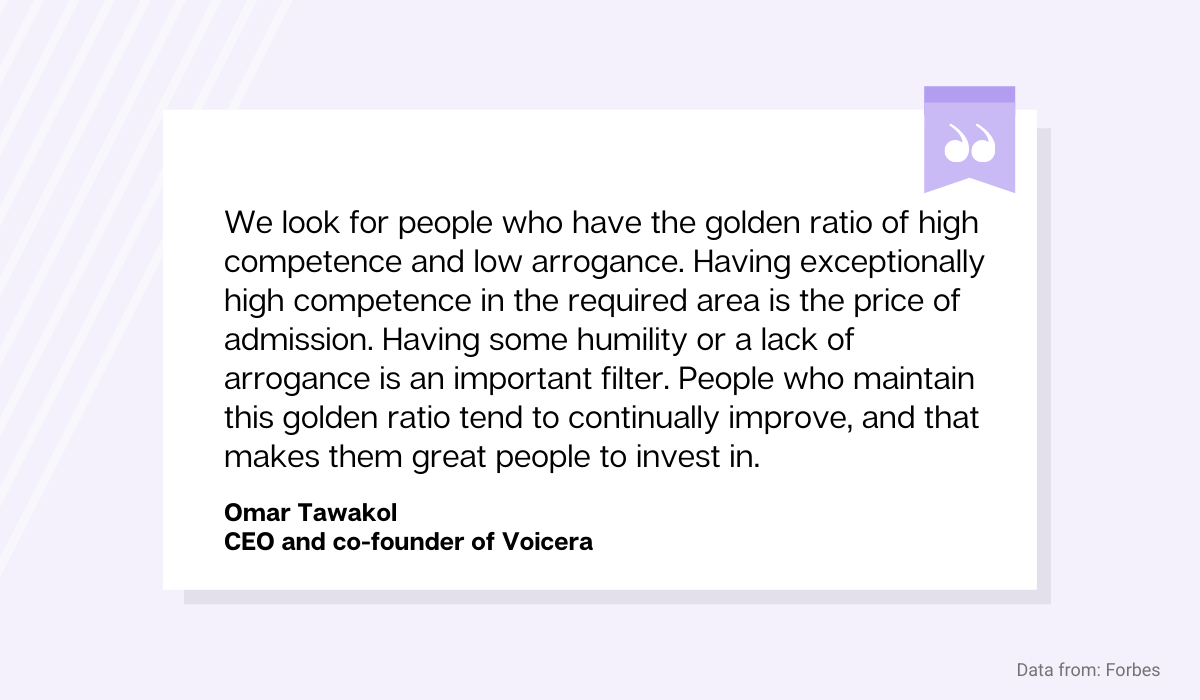
So let’s say Engineer Jessica has an innate curiosity and desire to learn new technology, a strong work ethic, and a positive attitude.
You can also add some additional traits that aren’t directly related to experience or skills.
For instance, if you have a lot of Star Wars fans among your employees, maybe someone who likes this franchise would be a good fit for your office culture.

So, Jessica loves traveling, photography, hiking, and Star Wars.
As you can see, just a quick glance at Jessica’s persona will enable you to get a clearer picture of what kind of engineers you are looking for, and ensure they will be a good fit for the role.
That also means that you’ll be more prepared to quickly make an offer when you find candidates like Jessica before they are snatched up by other companies.
However, keep in mind the following—in the tech industry where there are many specialties and niches, it can be challenging to find a person that checks all the boxes you’ve set.
Therefore, you don’t have to blindly follow your candidate persona, but rather use it as a guide to making sure you stay on the right track and hire the best engineer you can find for your role.
Promote job openings at the right places
In a world where the talent pool is shrinking and the competition is growing, how do you find top-notch developers?
The answer is simple: don’t rely just on traditional job boards. You need to cast a wider net.
LinkedIn is one of the most powerful sites for finding and connecting with future employees. In fact, 87% of recruiters use it to find candidates.
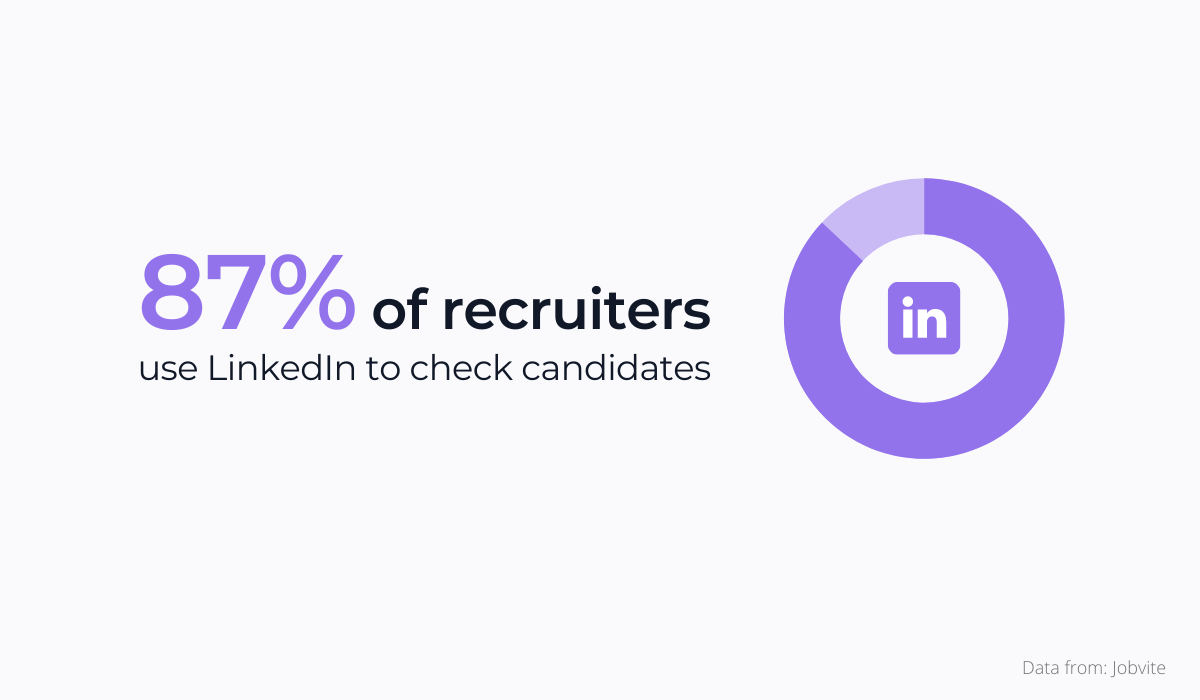
But that also means that everyone is on LinkedIn, which lowers your possibility of hiring your best tech candidate, especially if you’re competing with a bigger company.
Therefore, after you’ve posted your opening on all the usual sites such as LinkedIn, Indeed, or Glassdoor, it’s time to get creative and involve more people and places in the process.
For starters, create an engaging and fun post about the open position on your company’s Facebook, Twitter, or Instagram account.
And if you’re feeling really ambitious (and have the extra budget), consider putting together a video that explains what it’s like to work at your company or in the role itself, as Amazon did.
Check out their page and feast your eyes on these fantastic video ads where Amazon employees share what it’s like to be employed by the tech giant.
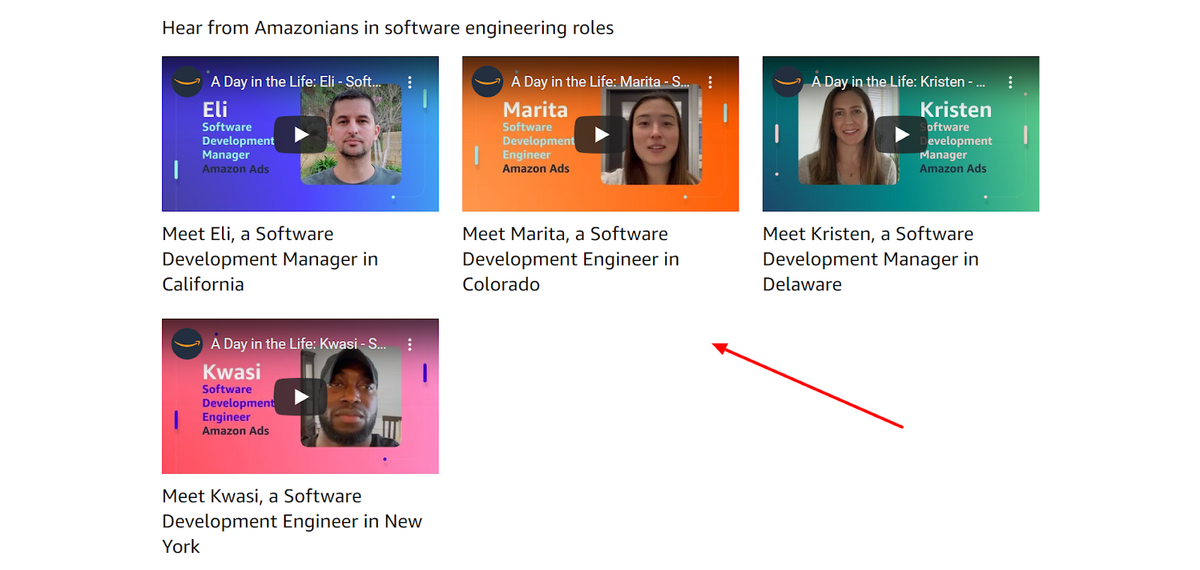
Then ask other team members to engage in the referral program and create their own posts about the position or to simply share yours and spread the news about the position.
The more people talk about your company’s open roles online, the better chance you have of finding someone awesome.

Keep in mind that referred employees take the shortest to hire and onboard, and the referral program itself improves the quality of the hire.
Reason more to engage your current developers in this process.
Next, you should create a career section on your site that highlights open positions, along with details about the company and its culture so applicants can learn more about your organization before applying.
For example, in Buffer’s career section you can find a list of current openings, an explanation of what it’s like to work at Buffer, and an overview of their culture and values, along with information about their benefits package.
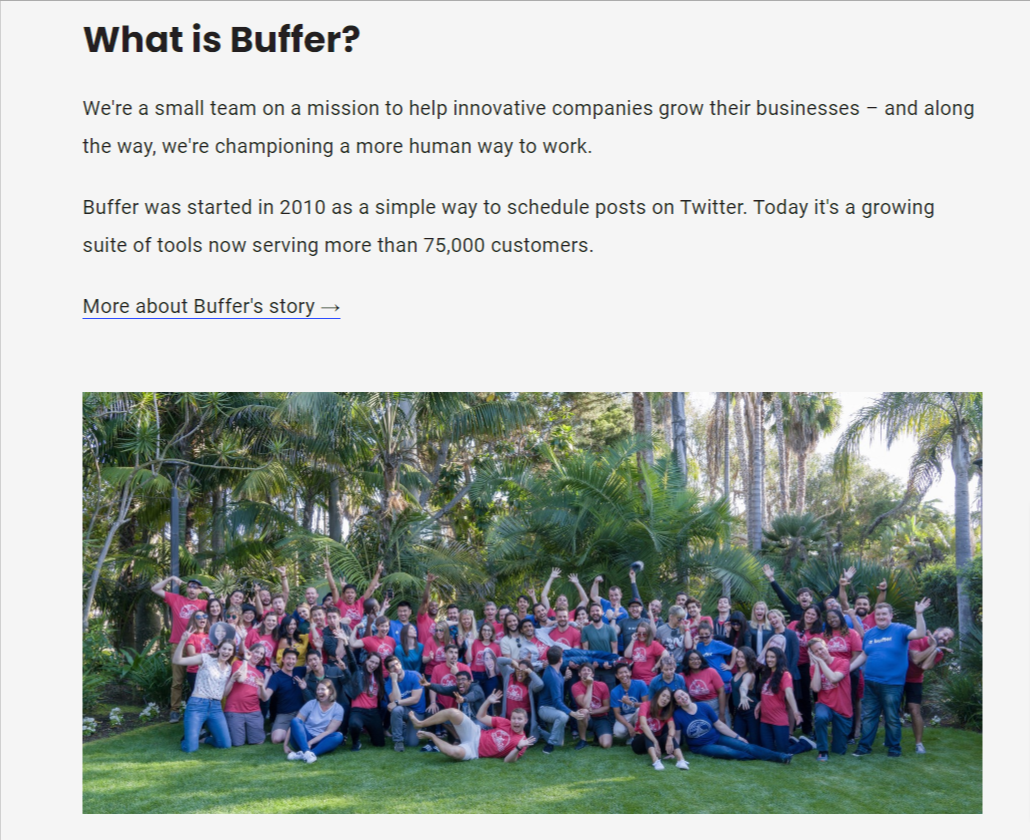
When potential hires visit Buffer’s website, they’ll make an assessment of whether or not they want to work for the company based on what they see and read.
This is a great opportunity to pitch your culture to your prospective candidates and spark their desire to come and work for you even before they send a resume.
And finally, don’t forget to post jobs on niche websites.
If you’re looking for someone who knows Ruby on Rails or has experience working with Python, consider posting your open positions on websites like Crunchboard.
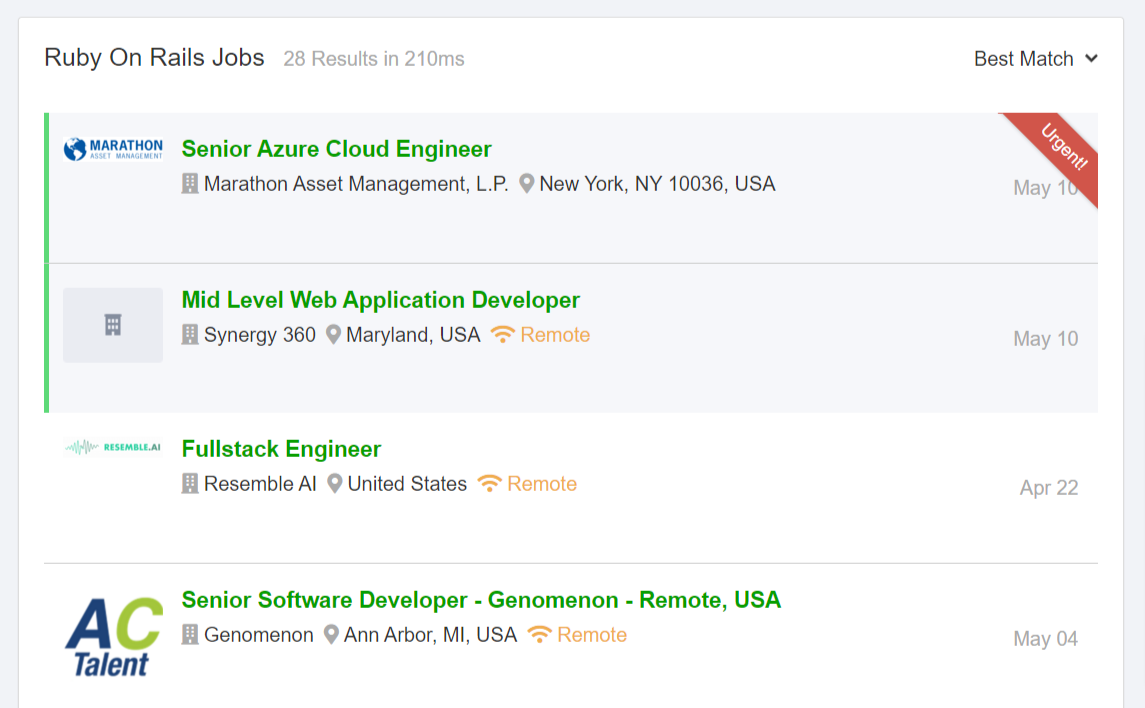
Sites like these target tech pros who are passionate about specific technologies, so they’re more likely to be interested in what you’re offering than those who just want any job they can get.
This is an excellent way to reach out to tech talents who aren’t actively looking for a new role but would love to change their job if the opportunity arose.
In conclusion, if you want to promote job openings at the right places and have a better chance of finding the ideal candidate then you have to include different channels in your recruitment process.
Only this way you will be able to create a diverse pool of applicants, and hire the perfect engineer for your role before the competition does.
Write detailed job descriptions
If you want to attract stellar tech candidates who can write exact and error-free code, you should start with a detailed job description.
But being detailed doesn’t mean you should overdo it. Keep in mind that the ideal length of a job description is about 600 words.
Therefore, a little bit of brevity will still be necessary if you want to make a good first impression on your candidates.

So the first step you should take is to clearly describe the role in terms of its responsibilities, skills, and requirements so candidates can easily understand what it entails and decide whether it’s something they want to pursue further.
When describing a role, include details about the technologies used daily and any specific tools required for completing tasks.
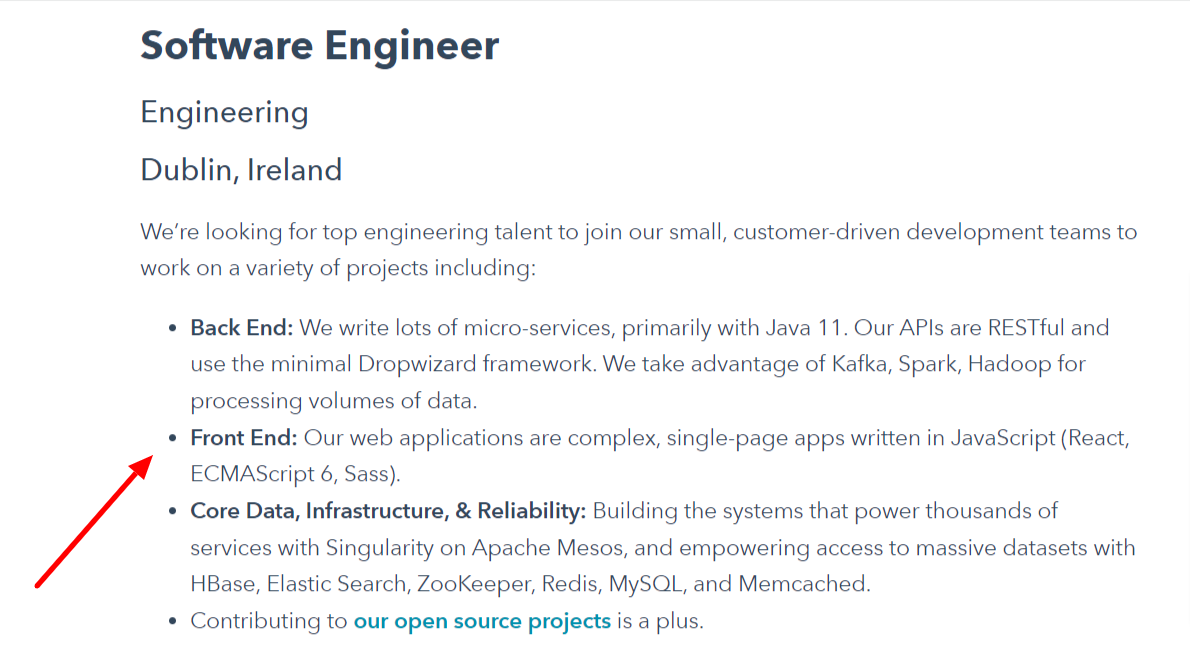
As you can see in the HubSpot job description for a software engineer, the requirements are extremely specific and straightforward: experience with JavaScript (React, ECMAScript 6, Sass), familiarity with relational databases like MySQL, and so on.
The reason behind it is simple: by making requirements so detailed and specific, they hope to attract only those applicants who are well-versed in their tech stack and have worked with similar technologies before.
Next, make sure you list all of the things they’ll need to do on a daily basis, like creating software code or troubleshooting bug reports from users.

If you do this right, you can lure in the best candidates for your business. If it isn’t clear what the role entails, you may miss out on some top talent altogether.
However, you should be extra careful here. If you want to attract candidates, make sure your requirements are reasonable.
Don’t ask them to do something that is unrealistic or impossible (e.g., develop a mobile app from scratch in one week).
This is especially off-putting when there’s no chance that the engineer will be able to complete this task on time.
Or how Robynn Storey, CEO of Storeyline Resumes, interestingly states in her LinkedIn post, job descriptions aren’t wish lists, and should be reasonable, not unattainable.
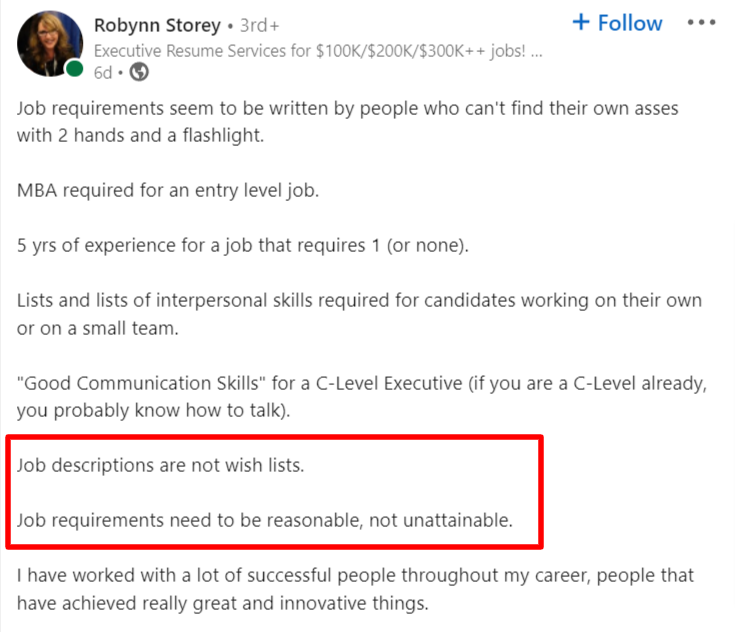
Additionally, when writing job descriptions, there is one thing that is often overlooked, and yet it is so crucial that it can serve as a rule of thumb: hire for values, not just skills.
One of the biggest mistakes companies make when writing job descriptions is focusing too much on the technical skills required, instead of the values and behaviors they expect from their employees.
As Simon Sinek outlines, skills are something that you can always teach—attitude, not so much.
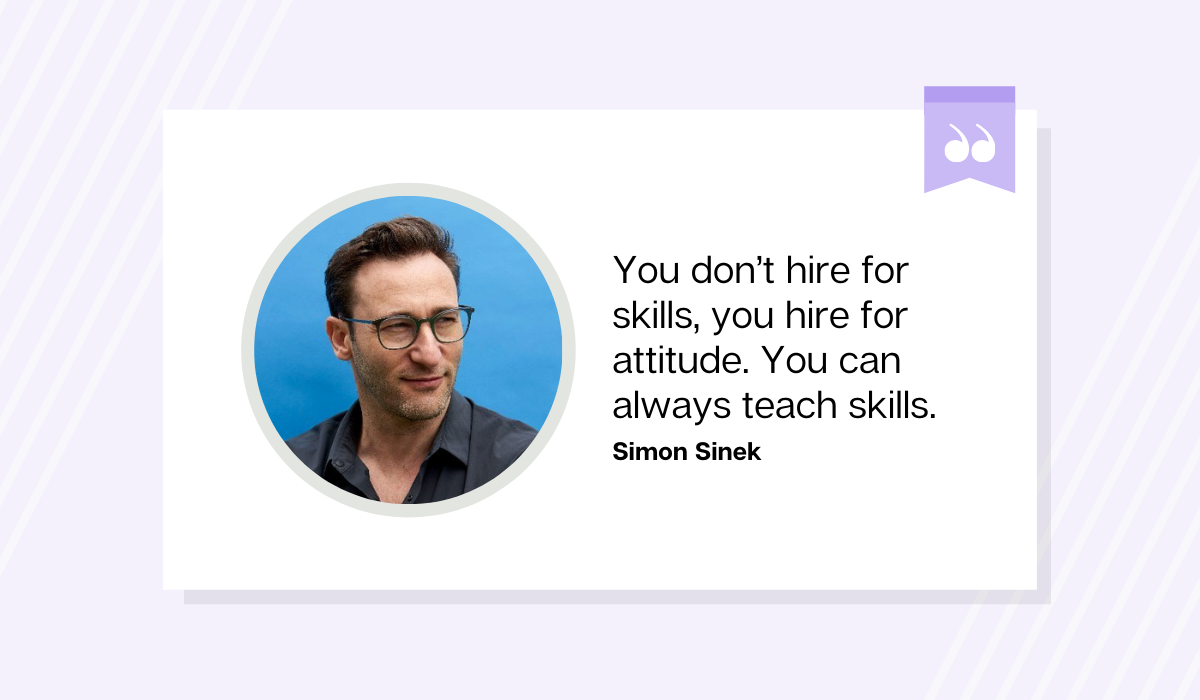
Many companies believe that soft skills are less important than technical abilities, but the latter are actually one of the most essential parts of any job description.
If you’re looking for someone who will fit into your team, then communicating those values will help you attract applicants who already have a similar mindset.
For example, Spotify lists the values front and center, right after the responsibilities.
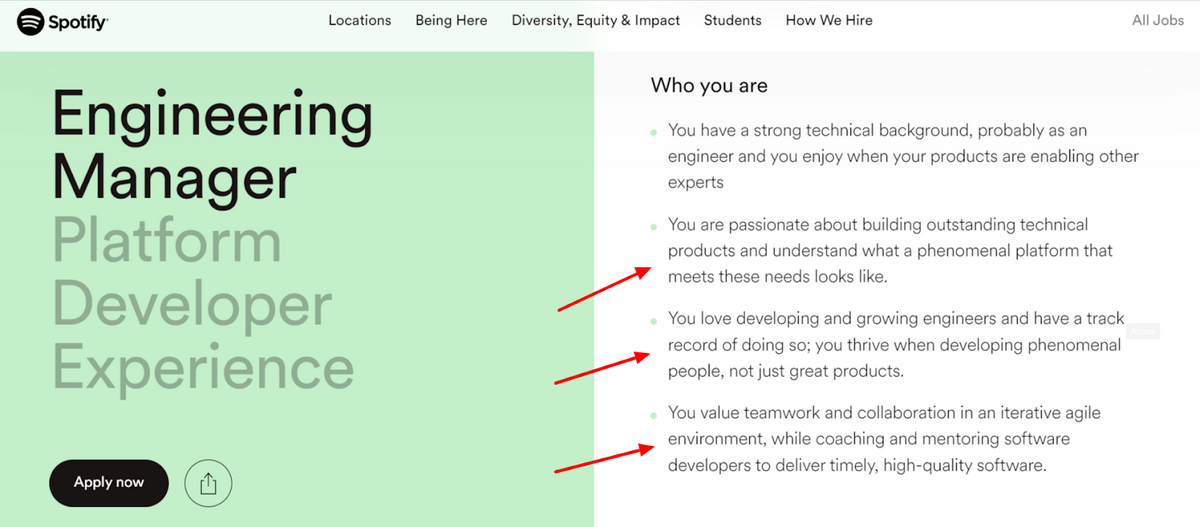
They want to hire candidates who are “passionate about building outstanding technical products.”
They also want people who “thrive when developing phenomenal people, not just great products.”
And they’re very detailed about it because they’re aware that while technical skills are necessary for a particular position and can be learned over time, having the right attitude towards work will help your company thrive in all aspects.
And finally, If there’s something unique about your company that isn’t obvious from its website, consider adding a sentence or two about it in your description.
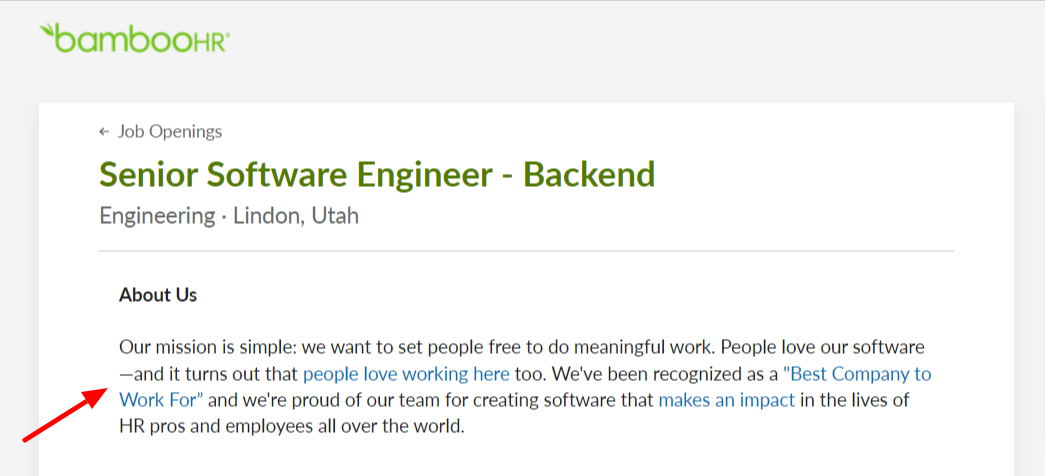
For example, if your company is recognized as one of the best places to work, as in the BambooHR case, mention this in your job description because it will attract a lot of stellar tech talents.
To sum up, job descriptions are more than just a list of duties and responsibilities–they’re marketing collateral.
They’re meant to get people excited about your company and sell your brand as an employer.
When you write detailed job descriptions, you’re not only helping potential employees get a clearer picture of what the job entails, but you’re also helping them see if it’s something they want to pursue.
If you write a good and thorough job description, chances are they will be quite interested in applying for the position.
And this is something that you should always keep in mind.
Showcase your company culture in multiple ways
When you have an open position at your company, it’s important that you highlight your culture to show why people should join your team.
This doesn’t mean that you need to go overboard with pictures of ping-pong tables and beer kegs. Instead, focus on highlighting what makes your company unique and special.
This includes benefits like flexible hours and telecommuting options as well as happy hours on Fridays–anything that makes it clear why someone would want to work for you.
And it’s well worth the effort considering that 66% of job seekers look at the company’s culture and values when considering their future career options.

Therefore, you can start by highlighting your company culture on your website using blog posts, videos, and photos.
Or you can dedicate an entire section on your website called Open, as Buffer did.
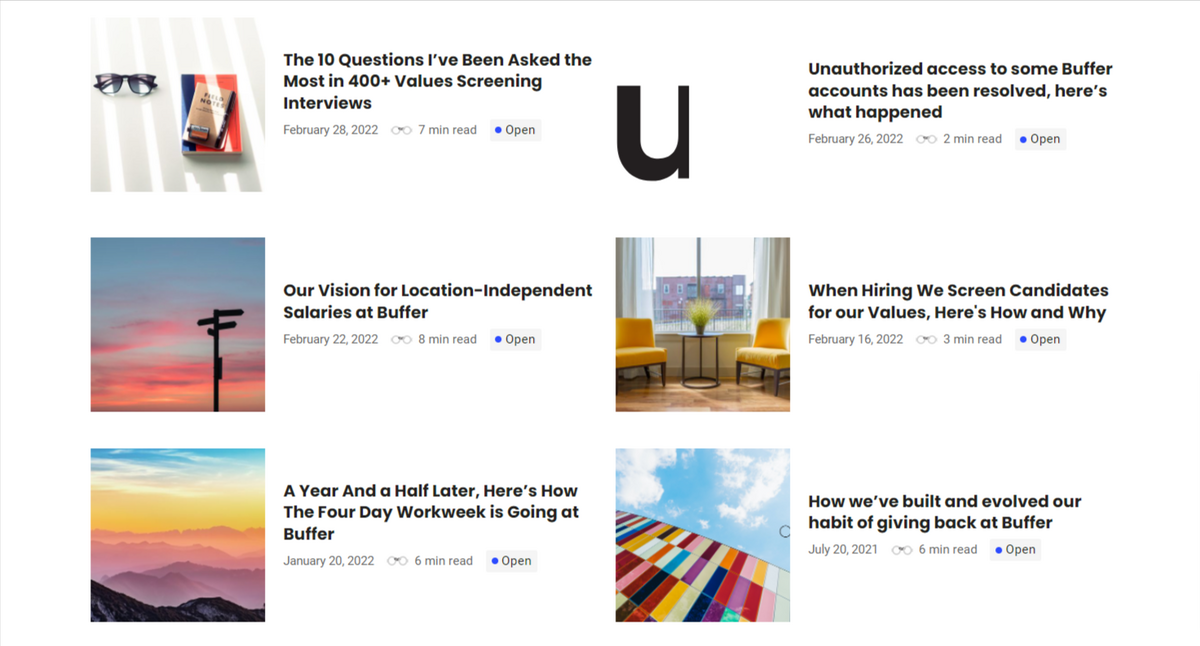
For instance, one blog post describes how they’ve switched to a four-day workweek giving their employees Fridays off. Another post outlines how they’ve lowered their gender pay gap.
There is a lot of talk about charity and giving back to society, and so on.
As you can see, they’ve put a lot of effort into it and we’re pretty sure that their potential candidates will likely be more impressed by Buffer’s company culture than other companies that don’t seem as invested in it.
Next, you should create a culture deck.
A culture deck is an outline of your company’s values and principles.
It should include descriptions of what you stand for, what your office environment is like, and where the company is headed in the future.
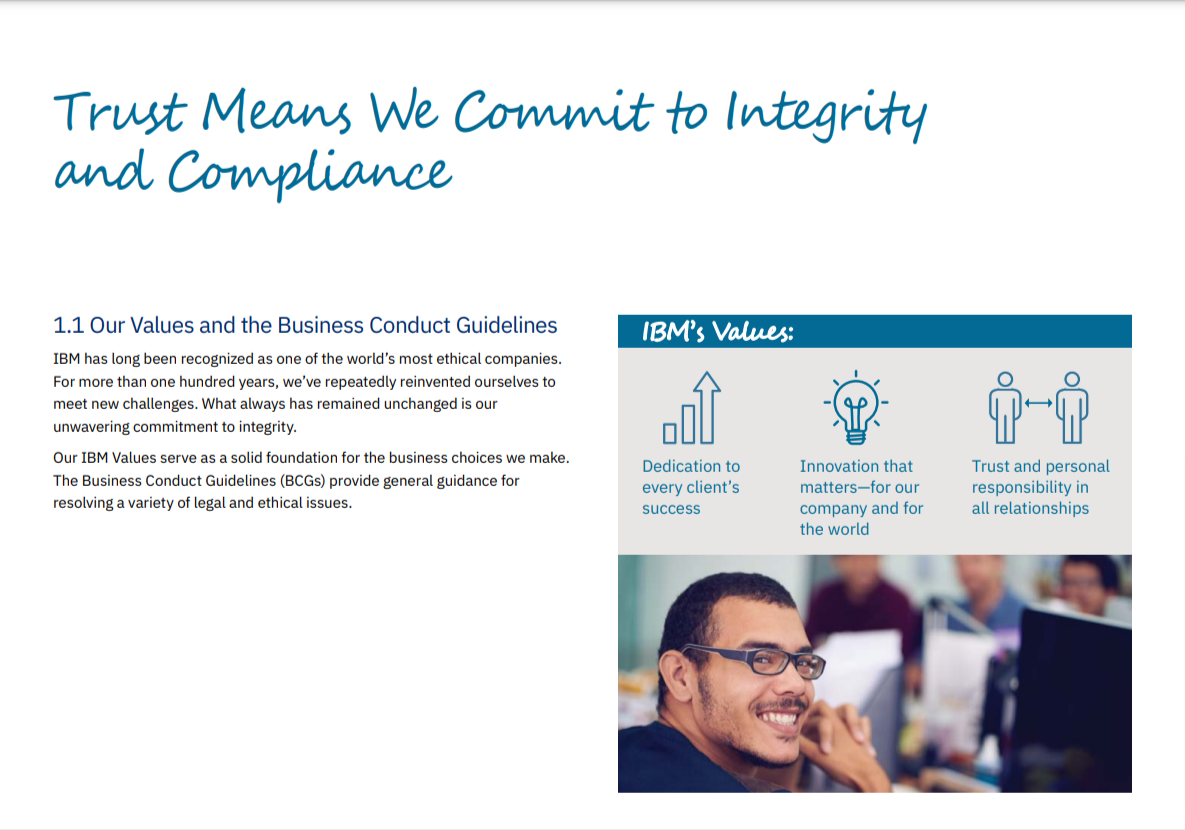
You can publish it on your website, as IBM did, and give your potential new hires a glimpse of what it would be like to work for your company.
Another good way to accentuate your company’s culture is to create a social media presence on Facebook and Twitter to attract tech candidates.
For example, you can share office photos on social media or even the ones where your team members hang out in outside activities.
This shows that your company is more than just a place to work–it’s also a place where employees can have fun.
Or do good deeds, as in the Cisco example where employees regularly give back by volunteering or participating in recycling events.
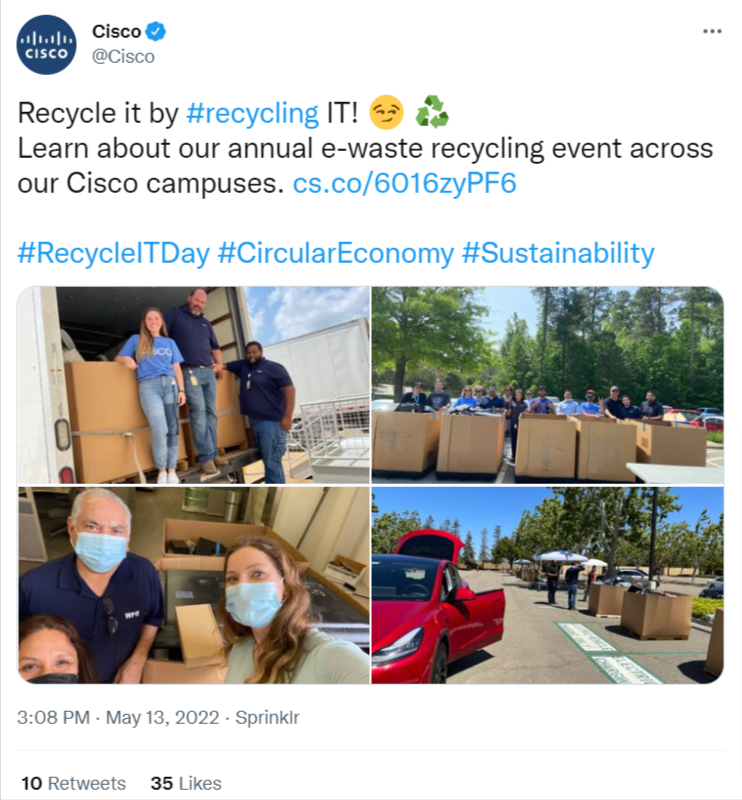
Remember, tech engineers want to work for companies that align with their values. Showcasing these values through culture helps candidates envision themselves working there long-term.
Therefore, it’s worth the effort to highlight the specific things that make your company special as it can be your competitive advantage in attracting and retaining top tech talents.
Conclusion
In the current job market, it’s not so much a question of whether you need to hire tech talent, but whether you can afford not to.
In fact, hiring stellar engineers is one of the best ways to ensure that your company stays competitive.
However, hiring tech talent can be challenging–especially if you don’t have the experience or knowledge of what to look for.
That’s why in this article we’ve laid out a blueprint on how to hire tech pros that will help you attract great candidates while also ensuring they’re a good fit for your organization.
We hope that it will encourage you to step up your hiring game and make your team better than ever!





